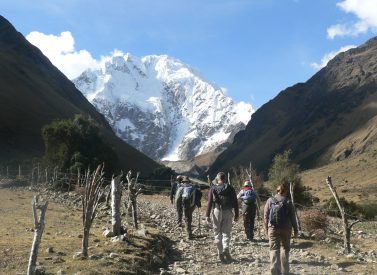Not the Inca Trail: The best treks near Cusco and Machu Picchu
 by Kathy Jarvis on 14th January, 2020
by Kathy Jarvis on 14th January, 2020
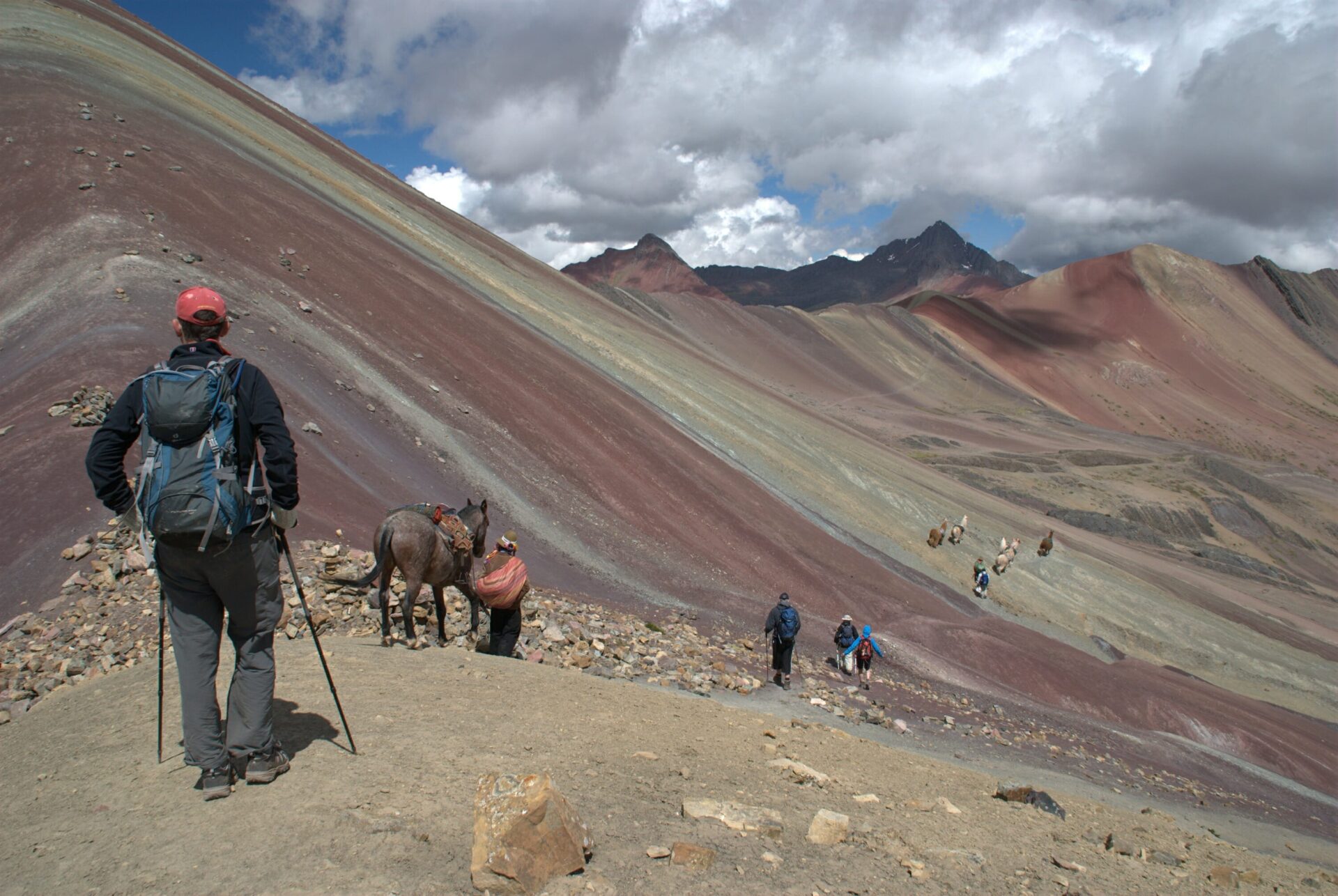
The best treks near Cusco and Machu Picchu
This week Kathy, co-author of the Bradt Peru trekking guides, takes us through what to do when the Inca Trail is sold out…….
Inca trail permits sold out
With the Inca Trail rigorously controlled through a permit system (500 a day) and constant high demand for this world famous trek it can be very difficult to secure a place.
So, if you find yourself booking your trip to Peru and then you find that the much sought after trekking permits are sold out then don’t despair, there are many other trekking alternatives.
The Inca Trail leads you to Machu Picchu through the Urubamba, or Vilcabamba mountains. Several alternative treks, less famous than the Inca Trail, but equally impressive, follow a very similar route through the same mountain range.
Other nearby mountain ranges nearby by such as the Vilcanota also offer plentiful trekking opportunities. There is no shortage of alternative stunning treks. You can complete a trek nearby and then visit Machu Picchu by train.
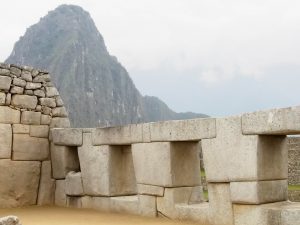
Machu Picchu
Alternative treks and when to go – a summary
• Lares – you can trek any time, but it is best to avoid the wetter, possibly snowy, months of Dec, Jan, Feb. We offer a camping trip and a lodge based Lares trek.
• The Moon Temple – you can trek any time, but it is best to avoid the wetter, possibly snowy, months of Dec, Jan, Feb.
• Salkantay– you can trek any time, but it is best to avoid the wetter, possibly snowy, months of Dec, Jan, Feb.We offer a camping trip and a lodge based Salkantay trek.
• Choquequirao trek to Machu Picchu – there is a small river that you may not be able to cross after heavy rain so avoid the wetter months of December to March.
• Ausangate – it is best to avoid the wetter, possibly snowy, months of Dec, Jan, Feb.We offer a camping trip and a lodge based Ausangate trek.
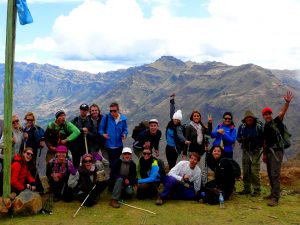
Happy trekkers
Further information on alternatives to the Inca Trail
Please note: Due to the high altitudes involved, we highly recommend that you take at least three or preferably even more nights at Cusco altitude or higher before starting any of the treks described below.
Choquequiaro is the exception to this as it starts low and goes lower still before gradually climbing back up.
Lares camping trek
Length: 30-50km trekking depending on the route
Time taken: Usually 4 days trekking plus a day to visit Machu Picchu (3/4/5 day treks available).
A cultural trek
The Lares area is one of the most traditional of highland Peru, home to scattered communities of farmers. The farmers generally live in single storey thatched stone houses, cooking on open fires. They speak Quechua and are excellent weavers, known for their homemade intricate red ponchos and decorative hats.
The people live a subsistence life, herding alpacas and llamas, growing a few hardy crops such as potatoes and beans on small plots. Some potato varieties, grown at high altitudes on the mountain sides, date back to long before the Incas.
Off-the-beaten-track trek
On this trek through the heart of the Urubamba mountains, there may be far fewer people than you see on the Inca Trail, where 500 people set off on trek every day. It is a lot less busy than the Salkantay trek route too.
The great advantage of this area is the variety of routes available. There are 3, 4, 5 (and more) day Lares treks, of a difficulty to suit different levels of fitness. You can select a trek length to suit you.
Trek terrain
On the Lares treks, you can enjoy good quality, well-walked paths through high mountain terrain. The paths tend to ascend and descend gently up and down the mountain passes, though the altitude makes this harder than at lower levels. The views of glaciated mountain peaks, lakes and small farming hamlets make this an interesting trekking area.
You go over passes around 4,000m / 13,123ft, but it is generally easier than Salkantay or Ausangate, and similar to the Moon Temple, though less remote, and with hot springs to soak weary legs.
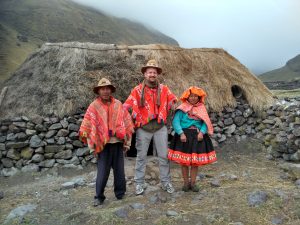
Meeting locals on Lares trek
Fully supported trekking – horses carry the loads
We don’t use porters on the Lares treks (we only use porters on the Inca Trail). We use pack horses and mules to carry all the camping equipment and your bags. This means you can take a bit more luggage with you, as there is no weight restriction.
As well as horses we provide a cook, an English-speaking trekking guide, all communal camping equipment, tents, dining tent, and transport to and from the trailhead. We take an extra horse in case of emergencies too.
Camp is set up for you, and meals served in the dining tent – you are well looked after. The cooks have many years of experience catering for trekkers and take great pride in providing healthy, nutritious mountain food.
The Moon Temple trek
Length: 47km trekking depending on the route
Time taken: 4 days trekking plus a day to visit Machu Picchu
A scenically stunning trek
This little know route runs close to the Inca Trail, through the same Urubamba mountain range. There are several high passes with scenic views of distant glaciated mountain peaks and green valleys below, plus you have the added attraction of several interesting Inca sites, including the enigmatic Moon Temple Read Maria’s blog for more.
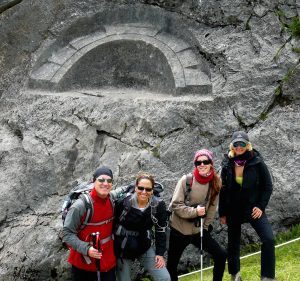
Moon Temple
Off-the-beaten-track trek
Few people know this 4-day trekking route that ends just upstream from Machu Picchu. You are unlikely to see any other trek groups once you set off on your first day of walking.
You really get away from other trekkers and immerse yourself in the beauty and rich culture of the Andes. This is a trek for beautiful views, remoteness and to get off the beaten track.
Trek terrain
Much as on the Lares treks, you walk on paths through high mountain terrain. The paths tend to ascend and descend reasonably – gently up and down the mountain passes – though there are some steeper sections. Trekking poles are useful and bear in mind that altitude makes this harder than it would be at lower levels.
Fully supported trekking – horses carry the loads
Pack horses and mules to carry all the camping equipment and your bags. In addition our trek support team will be with you, a cook, an English-speaking trekking guide and the horse men. We provide all communal camping equipment, tents, dining tent, and transport to and from the trailhead. We take an extra horse in case of emergencies too.
As on all our camping treks you get well taken care of. When you arrive at camp your tent will be set up for you and you’ll be treated to afternoon tea, followed by dinner served in the dining tent. We can cater for a variety of dietary requirements on the treks, remember to let us know what you can and can’t eat. Our cooks take great pride in good catering, providing healthy, nutritious mountain food for all the team.
Salkantay camping trek
Length: 60-70km trekking depending on the starting point
Time taken: 4 days trekking plus a day to visit Machu Picchu
A tough trek
This is one of the tougher treks, involving a breath taking tough climb to the high pass at 4,600m / 15,091ft, but it is a truly rewarding way to reach the Inca capital of Machu Picchu.
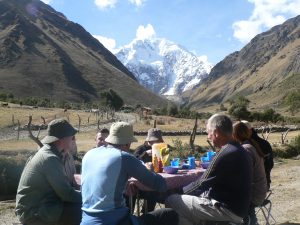
Having lunch, with views to Salkantay
A variety of eco-systems
On this trek through the Vilcabamba mountains you experience the most impressive changes in scenery and the biggest range of eco-systems of all the treks described here.
The mountain of Salkantay, considered sacred by main people in the Cusco area, is an astonishing 6,271m / 20,574ft high. It dominates the first two days of trekking and can be seen from miles around. Its huge ice covered bulk impresses more and more as you gradually get close up.
This trek takes you through an impressive sweep of altitudes as you climb the shoulders of this impressive peak, reaching 4,600m / 15,091ft at the icy pass before you then descend to 2,000m / 6,562ft, to warm, sub-tropical jungle buzzing with humming birds (and biting flies).
Inca ruins and a unique view of Machu Picchu
Not-to-be-missed is the last day of trekking through pristine cloud forest to the relatively recently rediscovered Inca site of Llactapacta. It was only in 2003 that British explorer Hugh Thomson and American archaeologist Gary Ziegler found the ruins, even though Hiram Bingham had been there in 1912.
Trek terrain
This is a busy trekking route and rivals the Inca Trail for sheer numbers of trekkers on the trail. The paths are well-trodden, and the third day has been affected by the opening of a road. Salkantay is not the remote mountain experience it once was, so whilst it is scenically stunning it attracts hoards of backpackers.
Fully supported trekking – horses carry the loads
As on all of our alternative to the Inca Trail treks, horses or mules to carry all kit including your bags. You just carry a daysack with things you need each day whilst walking. All camping kit is supplied and our local teams will take good care of you, setting up camp and providing nutritious meals.
Choquequirao to Machu Picchu
Length: 40km trekking
Time taken: 5 or 6 days trekking plus a day to visit Machu Picchu
A scenically stunning, tough trek
This is a tough but scenically stunning and still off-the-beaten-track trek. There are only a few people trekking this route each day, but there are plans for a cable car – so go now!
The ascents and descents are steep and long, the weather is generally hot and humid too. A very good level of fitness and the right gear are essential. This route is a challenge, hard on the knees, but if you like remote Inca sites, lush vegetation, orchids, flowers, and to be away for other then choose this one.
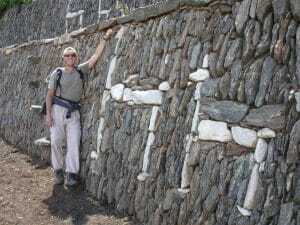
Llama wall, Choquequirao
Acclimatisation not required
The fabulous Inca site of Choquequirao is at 3,050m / 10,007ft, lower than Cusco.
The starting point for the trek is 2,900m / 9,515ft, then you walk downhill to the river Apurimac 1,600m / 5,249ft lower, before climbing back up to 3,000m / 9,842 ft.
You cross a pass above Choquequirao then drop down 1,400m / 4,593ft to the next river valley before climbing up again to the highest pass at 4,100m / 13,451ft. So, you can set off on this one without spending nights at Cusco altitudes, and by the time you finish you will be acclimatised for going on to other, higher treks.
Fitness and kit required
Be sure to take repellent for the biting black flies and quick drying light weight walking clothes, and water bottles to carry 3 litres or so. Don’t forget to take trekking poles, too.
Kathy our director recently returned from trekking the route- read her blog about the trek.
Fully supported trekking – horses carry the loads
As on above treks horses or mules to carry all the kit, so you only carry a daysack with things you need each day. All camping kit is supplied and our local teams will take good care of you, setting up camp and providing nutritious meals.
Ausangate circuit camping trek
Length: From 80km trekking depending on the route
Time taken: 6 days trekking (but there are many variations). Then add a day to visit Machu Picchu.
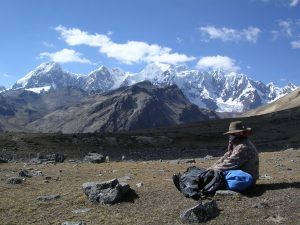
Ausangate trek
A scenically stunning, remote tough trek
This trek takes you through the remote, high Vilcanota mountain range, a totally different mountain area from the others, 80km south of Cusco. Views of the Vilcanota peaks are impressive, and from each camping spot you can see a different side of the towering Ausangate massif, with other peaks spread out around you. The clear cloudless nights offer an amazing display of stars, too.
Good acclimatisation and warm clothes required
Go prepared, a really good level of acclimatisation is required as you go high, with several passes around 5,000m / 16,404ft. The more acclimatised you are the more you will enjoy this trek. Take a good down sleeping bag and warm down jacket and that way you will be prepared for very cold night time temperatures.
Cultural trek
This is one of the most traditional areas of southern Peru. The people are mostly subsistence farmers, living as they have for centuries.
They herd alpaca, llamas and some cows and farm potatoes, oca, beans, just a few hardy crops that grow high and withstand heavy hail and cold nights. Most people live in single storey stone thatched cottages with an open fire. They weave and knit beautiful traditional patterns and maintain many age old traditions.
We offer a homestay experience in the Ausangate area, with the chance to see weavers, visit a guinea pig farm, a cheese plant and help milk the cow and plant or harvest potatoes. This at the home of a community leader, one of our team that we have worked with for over 20 years; a wonderful opportunity.
Fully supported trekking – horses carry the loads
As on above treks horses or mules to carry all the kit, so you only carry a daysack with things you need each day. All camping kit is supplied and our local teams will take good care of you, setting up camp and providing nutritious meals.
Contact us for more.
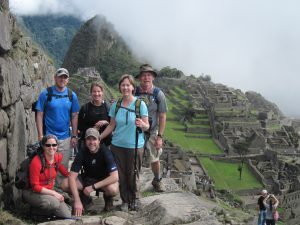
Trekkers at Machu Picchu


 a Group Tour
a Group Tour 